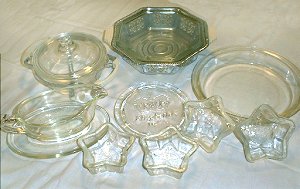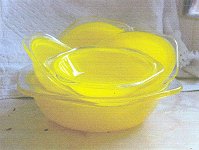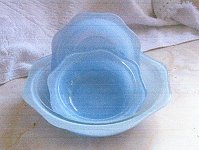 |
The British Heat Resisting Glass Company"Phoenix"
|
 |
 |
In July Nancy Curtis sent us the promised photo of
her Phoenix ware. Note the star moulds, which we have not come
across before. Nancy's photo arrived just in time for us to include it, and Matt's photos of his percolators, on the interpretation board on the display of Phoenix wares that we put on at the Bradely Gala at the Daisy Bank Community Centre. |
|
Ann Ramsbottom and Megan Fitzgerald-Plummer admire
their handiwork after they had arranged the display.
It turns out that Ann has a large collection of Phoenix too. |
|
|
During the course of the afternoon our display was visited by Brenda Wainwright who brought along this ashtray. The husband of one of her friends worked at Phoenix and through this connection Brenda got a complete set of Coronation wares, including dinner plates, a meat dish, two sizes of casserole, a fruit set - and this ash tray. Obviously Phoenix made a big thing out of the Coronation. |
After the Gala Ann Ramsbottom very kindly sent us some photos of her collection. Here are just some of them:
  A tea service in its original box, which is very rare. Note that it refers to "the new" opal glass. |
  Flan dishes and a deep, steep-sided bowl. And a variety of plate types with the yellow rose pattern. |
 |
Large serving bowls with their matching fruit bowls in yellow and blue coloured glass. |
 |
And not long after the Gala further information came to light. For the last few years the Public Record Office has been compiling a web site for its Access to Archives project. (You can find it at http://www.a2a.org.uk/ ). The site lists the holdings of the archive offices (public and private) round the country, adding new sets of catalogues from month to month. This union catalogue can produce amazing results: we have now found interesting information in the Derbyshire Record Office. (There is no way one would have thought of going there to see if they had anything relevant to Phoenix Glass, unless this web site had been in existence. This is one of the wonders of the Internet!).
From the entries on A2A it seems that the people who set up Phoenix were not called Jell but Gell. The Derbyshire Record Office refers to the Gell's "family firm, British Heat Resisting Glass Company". The Gells must be one of the oldest and longest established families in Derbyshire, having lived at Hopton Hall since at least 1327. In 1902 the then head of the branch of the family who lived at Hopton Hall leased the hall to another branch of the family, headed by Philip Lyttleton Gell. This branch of the family had been at Wirksworth, Derbyshire and are described as having "diverse business interests". In 1918 the Hall was sold but in 1926 it was sold again to P. L. Gell, who now became the owner instead of the lessee. But he died soon after and bequeathed the Hall to his nephew Philip V. W. Gell who, in turn, died in 1970. (The history of the Hall thereafter, and its recent rescue from decay, are interesting but not relevant to our story). Philip and his wife Aileen had two sons, one of whom, Philip Anthony Maunsell Gell, worked for Phoenix. The Derbyshire Record Office provides the following account of him:
Born on 9 Sept 1921 in Birmingham, he was educated at Eton and Magdalen College, Oxford, where he took a degree in jurisprudence. While at Oxford, he was Captain of the University Boat Team. During World War II Gell was commissioned in 1942 into the Coldstream Guards and served until demobilisation in 1946. Col. P.A. M. Gell then worked for the family firm, British Heat Resisting Glass Company, and became its managing director. In 1958 he started in Kingswinford a firm called Elemelt which pioneered electric melting furnaces, but sold his interest in the business in 1968. He died in September 1998.
So it seems that the firm's founder (or one of them) was P.V.W.Gell. From the sources which we used on the very first page of this history, he seems to have been a Colonel Gell. His son, P.A.M.Gell was also a Colonel Gell. (Well, they were both Colonels unless everybody's recollection of the the PVWG has become confused with PAMG). PAMG is said to have become the MD but we have other names in this post later on. It is just possible that PAMG left, or ceased active management, when he set up Elemelt - whose electric melting furnaces seem to have been for melting glass. David Encill tells me that, according to Toledo Engineering Co., Inc.'s web site, this company was formed in 1954 and taken over by TECO in 1984.
Unfortunately the Derbyshire Record Office has family papers for the Gells but nothing which relates to their business activities.
The Frank Sharman showed his whole collection of Phoenix wares at the Collector's Day at Bantock House in January 2006. At that event a visitor said "You should talk to my Father. He worked at Phoenix for years". As a result of that Frank went to see the gentleman concerned - Alf Crook. Alf gave us an enormous amount of information about the company. This is set out on another page:
click here to read Alf Crook's account
In June 2006 Dr. Joy Duff sent us a most interesting extract from one of the diaries which many people kept for the organisation Mass Observation. Accounts of the lives of ordinary people are now being published based on these diaries. In one of these, "Our Hidden Lives", by Simon Garfield, Ebury Press, 2004, Joy found the following entry from the diary kept by Edie Rutherford in Sheffield. The extract is dated Sunday 20th April 1947. It reads: "Yesterday while getting luncheon served a cracked Phoenix dish fell apart in my hand and middle left finger on left hand has a nasty cut across top. I reckon Pyrex-ware has Phoenix beat & will never buy Phoenix again." This is all very unfortunate. I am sure that, at the time, Phoenix would have been convinced that they had a better product but they could have done with Edie Rutherford telling her friends (as she undoubtedly would have done) about her accident and how Phoenix were to blame. But is it interesting that, at the time, Edie, and doubtless others, clearly understood that Phoenix and Pyrex, despite their many similarities, were different companies and products, and that Phoenix and Pyrex were going head to head in the market.
 click here to continue the Phoenix story |